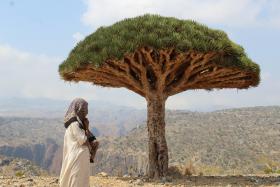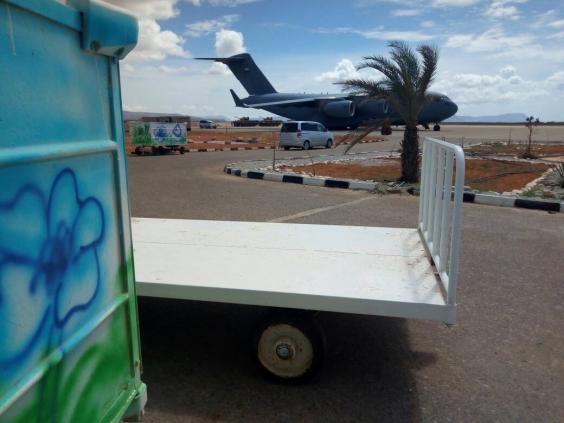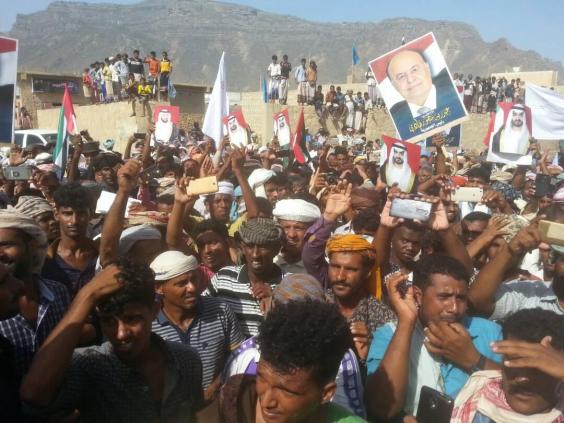Date: Monday, 21 May 2018
The Independent presents the final article in an exclusive series from Socotra. The Arab coalition united against Yemen’s Houthi rebels has declared the infighting over the Unesco-protected island over: In reality, the supposed alliance is fracturing across Yemen

Monsoon season has almost arrived on the Socotra archipelago.
Overnight on Thursday, the first storm of the year, Cyclone Sagar, began forming over the Gulf of Aden. As the winds picked up to 80kph (50mph) and the water began to churn, fishermen were warned not to take their boats out.
For the next two months, the Arabian Sea will be too dangerous to cross and the isolated Yemeni island will be almost completely cut off from the outside world.
The only way on or off the Unesco-protected paradise will be the airstrip. It’s not clear, however, whether any of the three flights a week will run. No one really knows who’s in charge.
In the last two weeks the Arab coalition helping Yemen’s exiled government fight Houthi rebels on the mainland has ruptured in a standoff over geopolitically strategic Socotra. The island’s 60,000 inhabitants have taken to the streets demanding either the removal of the United Arab Emirates (UAE), the Yemeni government, or independence from both.
The UAE bought tanks and heavy artillery to the island for the first time, and kicked Yemeni workers out of the airstrip and port. The Yemeni government, enraged at the violation of its sovereignty, responded by inviting a Saudi delegation to act as peace broker. The Saudis also brought troops, which appear to have remained.

Yemen’s prime minister Ahmed Obeid bin Daghr announced on Monday that the “crisis on the island is over” and that Yemen’s flag is “flying above our sea and airports again”. But in conversations with residents, local leaders and activists in Socotra, The Independent has discovered the picture on the ground looks very different.
Our eyewitness report revealed how since Yemen’s war began the UAE has all but annexed Socotra, building a military base, conducting its own census and possibly even holding a Crimea-style referendum.
With Saudi Arabia beginning to assert itself on the island, the Emirates’ quiet ambitions in this part of the world are now being directly challenged.
A clever blend of Emirati hard and soft power is rapidly changing life for people in Socotra and southern Yemen, as well as Somaliland, Djibouti, Eritrea and Port Sudan – all places which touch the Red Sea, the world’s most important oil and gas shipping channel.
Socotra, the epicentre of this new power struggle, has become the first real challenge for the UAE as it strives to establish a 21st-century military empire to rival Saudi Arabia’s regional dominance.
Socotra now holds the key to the future of the strained Arab coalition and the future of Yemen, a country already coming apart at the seams.
Ahmed bin Daghr flew to Socotra two weeks ago for a rare visit designed to reassert Yemen’s sovereignty over Socotra. Instead, many sources on the island think the prime minister found himself trapped there, subject to the whims of the UAE, which rolled out tanks in a show of military might.
The panicked Yemeni delegation called the Saudis – the keystone of the coalition and main financial backer of the war against the Iran-backed Houthis – to send a mediation committee. Talks over several days after Yemen officially demanded the UAE scale back its military presence did not go well. On 13 May, the Saudis landed another plane, this time carrying armed troops.
“The presence of Saudi troops is alarming,” Tawakkol Karman, a Yemeni human rights activist and Nobel Peace Prize laureate who has been vocal about the situation on Socotra, told The Independent. “We should not trust these agendas.”

In a Facebook post sent from the safety of the Saudi capital of Riyadh on Thursday, Daghr announced he had finally returned home to the seat of the exiled Yemeni cabinet and that Socotra was safely in Yemeni hands once more.
Pictures have surfaced of Emirati tanks and armoured vehicles being loaded back onto a C-17 military cargo plane. It is not clear whether the Saudi soldiers remain on the island; The Independent's requests for information from Riyadh, Aden and Abu Dhabi have not been answered.
Not everyone is convinced this is the end of the matter. Even officials within Yemen’s government are not towing the official line.
One pro-UAE local government official on Socotra told The Independent Emirati troops are staying on the island and people are “happy with that fact”.
And Tarek Salam, the governor of Aden, Yemen’s interim capital which is de facto run and defended from al Qaeda by the UAE has been critical of Emirati activity on Socotra, which he says is continuing.
“They still want to transform this beautiful island full of protected landscapes into one of the Emirates, the ‘eighth Emirate’,” he said in an interview with UNews TV on Wednesday.

The UAE now has competition.
“Not only will the UAE not really leave Socotra, there are now Saudi forces there as well,” Karman said.
“We refuse to replace the UAE occupation with a Saudi one. These countries are just taking turns to devastate Yemen and impose control, and on Socotra that affects the rare ecosystem there too,” she added.
Now they’ve arrived, the Saudis seem intent on staying: On Thursday the Saudi ambassador to Yemen, Mohammed Al Jaber, announced that his country would be covering all of the underdeveloped island’s water and electricity needs from now on – a role previously filled by the UAE.
At a ceremony covered by Saudi news outlets, Jaber laid a foundation stone at the site of three new wells in the main town of Hadibo, the first of several planned construction projects.
The coalition is now all smiles and handshakes over Socotra. “The crisis is definitely over,” Yemeni cabinet spokesperson Rajeh Badi said via WhatsApp.
Coalition spokesperson Turki al Malki told media in comments aired on Saudi Arabia’s al Arabiya TV that Socotra is being run “in coordination” between the Yemeni government, Riyadh and Abu Dhabi.
The UAE, which has not publicly addressed the standoff except to say it has “no ambitions in sisterly Yemen or any part of it”, released a statement last week detailing “two decades of development and support” provided to the island.
Discontent over the Saudi and UAE role in Yemen’s complex three-year-old war is still brewing on both the island and Yemen’s mainland, despite the fact the authorities have drawn a line under the Socotra incident.
Aden’s governor is not the only agitator. Mahra on Yemen’s east coast used to be part of a sultanate which also included Socotra until the British created a protectorate in 1886.
Sheikh Abdullah bin Issa al Aafrar, an Oman-based and Omani-funded descendent of the old Sultan, is now positioning himself as an alternative option for Socotra and Mahra’s future.
Mahra, home to Saudi forces since December last year, is becoming tense and more polarised as a result, said Dr Elisabeth Kendall of Oxford University.
“Saudi Arabia has succeeded in winning some support among the northern desert tribes in Mahra, owing to its efforts to clamp down on smuggling and its donations of much-needed equipment like generators,” she said.
“But there is still much hostility to Saudi intervention.”
Reported Saudi plans to open a conservative religious school angered locals, and worried peaceful neighbouring Oman.
Sheikh Aafrar visited Mahra earlier this month, whipping up anti-coalition sentiment with protests and sit-ins demanding the Saudis vacate the area, and the UAE leave Socotra.
The unrest is fuelled by the fact no details about the supposed deal struck for Socotra have been released.
Despite statements of concern and calls for “de-escalation” from the US State Department, Turkey and the office of Martin Griffiths, the UN envoy to Yemen, the Arab coalition’s conclusions remain unknown.
“I doubt that Socotra will be abandoned by the coalition, despite current claims that an agreement has been reached which will see the departure of UAE forces from the island,” Dr Kendall said.
“The issue has also highlighted many coalition fault lines.”
On the island itself, many residents expressed relief that the tensions of the last few weeks appear to have eased.
But even if the presence of Saudi or UAE officials is now declared to be purely for humanitarian or development interests, Socotris are keenly aware that their long-isolated paradise is no longer safe from the vagaries of Yemen’s war and the ambitions of its players.
“Maybe this was always going to happen,” an anti-UAE activist from Socotra who has since left the island said.
“Maybe nowhere can stay an island forever anymore. But I am sad I have lived to see this and I have no power to change it.”